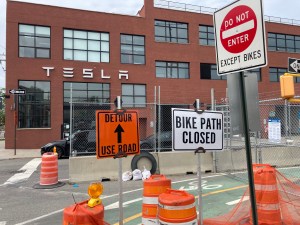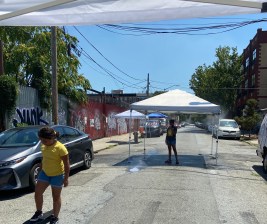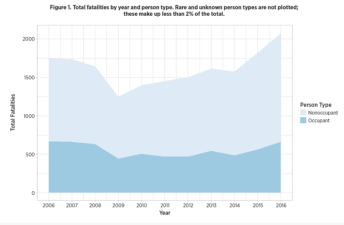Traffic Engineering by Body Count

Van Brunt and Wolcott Streets. Before paint, July 7. After paint, July 14.
The New York Observer’s Real Estate reported that the woman struck by a mini-van pulling out of the Fairway Market parking lot in Red Hook on Thursday, July 6, has died. The Daily News identified her as Janett Ramos, 45, of Sunset Park.
Despite the rapid increase in Van Brunt Street traffic created by the new Fairway and Red Hook’s booming development, the Department of Transportation has said that it will not begin studying the area’s traffic until Fall. Nevertheless, the agency has restriped the intersection where Santos was killed as well as some other intersections along Van Brunt.
At the end of May, DOT Commissioner Iris Weinshall found time between Fairway shopping trips to tell NY1, "We wanted the store to open up, we wanted to see people develop their traffic patterns, and then we’ll be back here in the fall, we’ll put our counters down, and we’ll see if any of the corners will meet warrants to put up traffic lights."
Two editorial comments on the DOT’s methodology in Red Hook:
1. Traffic signals and paint stripes are not the only or even the best tools for calming and controlling traffic in city neighborhoods. There is an entire school of engineering and street design called "traffic calming" (Warning: Links to a PDF document but it’s worth the click). Van Brunt Street, a 16-block straightaway from the Battery Tunnel to the new grocery store, is a natural candidate for traffic calming.
We have reason to believe that DOT Deputy Commissioner Michael Primeggia does not like traffic calming and that he believes that his job is to keep the city’s traffic moving, not to calm it. On June 23, 2003 at a meeting in Brooklyn Borough Hall, I watched Primeggia deliver the coup de grace to the Downtown Brooklyn Traffic Calming Project, a six-year, $1.2 million community-driven initiative run by an internationally-respected consulting firm. Red Hook should not let one agency honcho stop it from demanding real traffic calming as a part of its development process.
2. Red Hook needs real transportation planning. In many cities, sometimes even in New York City, it is standard practice for transportation agencies to model and plan for traffic prior to the opening of big new grocery stores, cruise ship terminals and Swedish furniture behemoths. In Red Hook, Commissioner Weinshall has, essentially, chosen to identify trouble-spots by waiting to see where the traffic clogs and the bodies pile up. This is traffic engineering by body count.
It is similar to the methodology DOT used at Queens Boulevard, the infamous "Boulevard of Death," in the late 1990’s. In the Queens Boulevard Pedestrian Safety Study, the City’s consulting engineers only examined locations that had two crashes in the same spot. Their attitude was that one crash could just have been an accident. Two crashes indicates a real problem, worthy of mitigation.
On the one hand, you can’t argue with success. Fatalities on Queens Boulevard are way down since DOT’s re-engineering. Counting dead and injured bodies is clearly an effective way of identifying the worst vehicle-pedestrian conflict spots. On the other hand, it isn’t particularly effective if you or someone you know is included in the counting.
There ought to be a way to plan and engineer New York City’s streets without turning New Yorkers into human guinea pigs. But until we have a transportation agency capable of doing that, the beleagured residents of Red Hook may consider offering up a second human sacrifice at Van Brunt and Wolcott. That ought to warrant a traffic signal.
Photo: The Real Estate.


